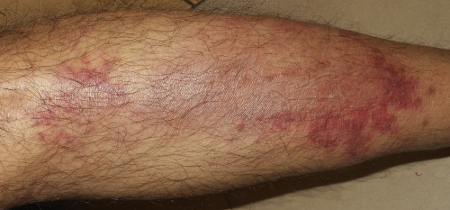History and exam
Key diagnostic factors
common
jaundice
Suggests biliary obstruction or, very rarely, hepatic or hilar nodal metastases.
nonspecific upper abdominal pain or discomfort
weight loss and anorexia
Other signs of advanced disease include weight loss and anorexia. Rapid weight loss is usually associated with unresectability.[36]
back pain
Pancreatic cancer may present with back pain in the absence of abdominal pain, due to direct invasion of the celiac plexus or as a consequence of pancreatitis.[36] Persistent back pain is associated with retroperitoneal metastases.
Other diagnostic factors
common
age 65-74 years
Pancreatic cancer is a disease of older people, with a peak incidence in people ages 65-74 years.[8]
uncommon
steatorrhea
Extensive pancreatic infiltration or obstruction of the major pancreatic ducts will cause exocrine dysfunction resulting in malabsorption and steatorrhea.
Patients report oily, foul-smelling stools that are difficult to flush away.[36]
thirst, polyuria, nocturia, and weight loss
Endocrine dysfunction, resulting in new-onset diabetes presenting with thirst, polyuria, nocturia, and weight loss, is present in 20% to 47% of patients.[37]
Pancreatic cancer should be considered in adult patients (50 years or older) with new-onset diabetes but without predisposing features or a positive family history for diabetes mellitus.[1][5][37]
nausea, vomiting, and early satiety
unexplained acute pancreatitis
Pancreatic cancer should be considered in older patients with an unexplained episode of acute pancreatitis.[36]
hepatomegaly
Sign of advanced disease with hepatic metastases.
epigastric abdominal mass
Sign of advanced disease.
positive Courvoisier sign
Sign of advanced disease (indicated by painless palpable gallbladder and jaundice). Present in <25% of patients.[36]
petechiae, purpura, bruising
Signs of disseminated intravascular coagulation in advanced disease.
Trousseau sign (migratory thrombophlebitis)
Because patients with pancreatic cancer have an increased risk of thromboembolic disease, venous thrombosis or migratory thrombophlebitis (Trousseau sign) could also be a first presentation of pancreatic cancer.[7][Figure caption and citation for the preceding image starts]: Trousseau sign in a patient with pancreatic adenocarcinomaPunithakumar EJ et al. Trousseau syndrome in pancreatic carcinoma. Surgery. 2021;169(2):E3-4; used with permission [Citation ends].
Risk factors
strong
smoking
It is estimated that 1 in 5 cases of pancreatic cancer can be attributed to cigarette smoking.[13] People who smoke have a 1.74-fold risk of developing pancreatic cancer.[12][13]
Risk of pancreatic cancer increases with smoking duration, intensity, and cumulative dose.[12] Risk reduces after smoking cessation to 1.2-fold, but it remains elevated for 10-20 years, compared with never smokers.[12][13][22]
family history of pancreatic cancer
Criteria for familial pancreatic cancer are at least two first-degree relatives with pancreatic cancer, or at least two second-degree relatives with pancreatic cancer, one of whom had early-onset pancreatic cancer (<50 years of age), without the presence of other inherited cancer syndromes. The risk of pancreatic cancer increases with the number of relatives affected, suggesting autosomal-dominant inheritance of a rare allele.[23] Although the main gene responsible has not yet been identified, a germline mutation in BRCA2 can be found in up to 20% of families.[17]
other hereditary cancer syndromes
A genetic predisposition for pancreatic cancer may be present in 5% to 10% of patients. In familial pancreatic cancer, the risk of pancreatic cancer increases with the number of first-degree relatives affected.[16][17]
Hereditary pancreatitis: mutations in PRSS1 gene and an estimated 35% lifetime risk of pancreatic cancer.
Peutz-Jeghers syndrome: mutations in the STK11/LKB1 gene and an estimated 36% lifetime risk of pancreatic cancer.
Familial atypical multiple mole melanoma syndrome: mutations in CDKN2A tumor suppressor gene (which encodes cell cycle inhibitor p16) and an estimated 17% lifetime risk of pancreatic cancer.[24]
Familial breast cancer syndrome: BRCA1, BRCA2, and PALB2 mutations; the risk of pancreatic cancer is dependent on the number of relatives affected.
ATM gene mutations: associated with 3-fold increase in risk of pancreatic cancer.[25]
Hereditary nonpolyposis colorectal cancer syndrome: mutations in hMLH1 or hMSH2 and an estimated risk of about 5%.[18]
weak
chronic sporadic pancreatitis
Patients with chronic pancreatitis are at a higher risk of developing pancreatic cancer.[26] However, the risk is difficult to assess because there are usually confounding factors such as smoking, high alcohol intake, or other potential biases. Relative risks of pancreatic cancer varying from 2.3% to 18.5% have been reported.[27]
diabetes mellitus
Some evidence suggests that there is a 1% chance of developing pancreatic cancer within 3 years of diagnosis in people diagnosed with new-onset diabetes mellitus.[5] However, estimates of the magnitude of increased risk of pancreatic cancer in people with diabetes vary.
obesity
One systematic review of prospective studies of the association between body mass index, abdominal fatness, and pancreatic cancer risk in patients with pancreatic adenocarcinoma found that being overweight or obese was associated with a greater risk of pancreatic cancer.[28] Obesity at older ages, or shortly before cancer diagnosis, was associated with a reduced overall survival; however, the reported risks vary.[29]
Use of this content is subject to our disclaimer